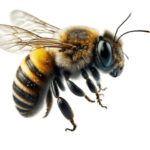BEES & WASPS TREATMENTS

BEES
Bees are important pollinators critical for agriculture and natural ecosystems. They live in colonies with a queen, worker bees, and drones. While essential for pollination and honey production, bees can sting defensively. Threats like habitat loss, pesticides, and diseases endanger bee populations, highlighting the need for conservation efforts to safeguard these vital insects.

WASPS
Wasps are flying insects recognized for their slender bodies and typically bright colors. They serve as natural pest controllers by preying on other insects. Unlike bees, wasps can sting multiple times when provoked. They construct nests from paper-like materials in protected locations such as eaves or tree branches. While some species are solitary, others form colonies with queens and worker wasps. Wasps are drawn to sugary foods and can be bothersome during outdoor activities.
Bees & Wasps Treatment
Importance of Bees: Bees are vital pollinators crucial for the survival of flowering plants and a significant portion of our food supply depends on their pollination services. However, bee populations have been declining, posing a threat to agriculture and ecosystems.
Chemical-Free Bee Removal: At Sydney’s Best Pest Control, we prioritize safe and humane bee removal processes. This includes carefully relocating bees, honeycombs, and hives without the use of harmful chemicals. Removal methods vary depending on the circumstances and location of the hive.
Swarm Removal: Swarms, often found hanging on trees or fences, are gently vacuumed into a screened box and transported to bee farms for relocation.
Formed Colony Removal Methods:
Method 1 – Trapping: For colonies in structures where creating an opening is impractical (e.g., brick or stone), a one-way trap is installed over the main entrance. This allows bees to exit but prevents them from returning. A trap hive baited with a queen bee encourages bees to relocate, weakening the original colony.
Method 2 – Cut Out: This method involves physically removing bees and their entire comb. The nest is exposed, bees are vacuumed, comb is cut into sections and transferred into frames, and the cavity is cleaned and sealed.
Preparation:
- Ensure all windows and doors are closed during removal.
- If anyone is allergic to bees, keep them away from the removal area.
- Avoid spraying the nest with insecticides, as this can harm the bees and contaminate honey.
Benefits: Both removal methods aim to minimize structural damage and ensure all remnants of the colony are safely removed, promoting long-term prevention of future hives.
